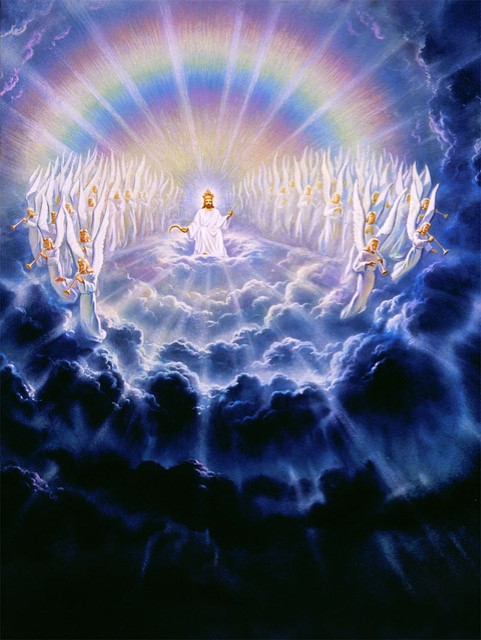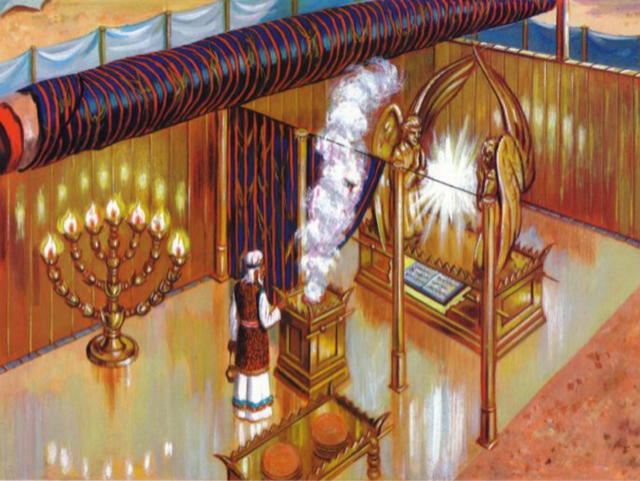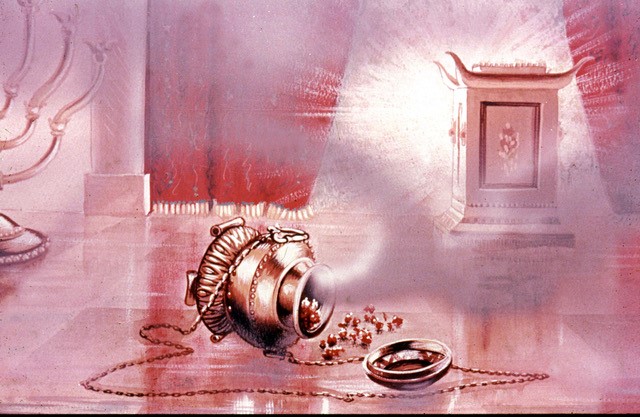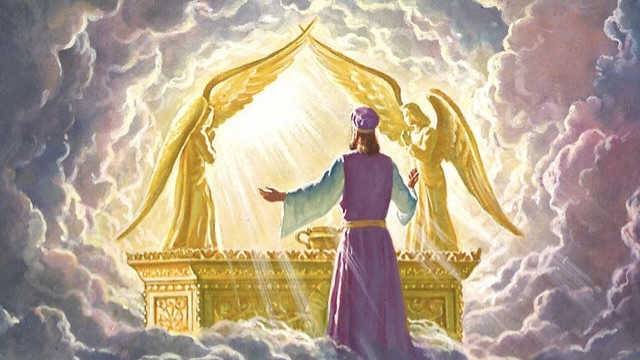Book of Revelation – a series presented by pastor Michael Walker
Lesson #7 – Revelation, chapter 8
Chapter 7 is in parenthesis between Revelation 6:17 and Revelation 8:1 in order to answer the question posed at the close of the 6th Seal. It then continues with the opening of the 7 Seals:
(1) The scenes as well as the chapters in the Book of Revelation do not follow in a chronological order. The Second Advent takes place under the 6th Seal; but it also takes place when the 7th Trumpet has sounded under the 7th Seal. Therefore, the 7 Trumpets are covering previous ground but with another focus or emphasis.
(2) The 7th Seal therefore focuses more closely upon: (a) Christ’s intercessory ministry on behalf of His people; and (b) God’s Judgements, in the appearing of the 7 Trumpets, upon those prominent international powers that affected His Church.
vs. 1-5
The Bible was written long before it was organized into chapters and verses. Revelation 8:1-5 is a continuation of the previous chapter. These verses contain a separate scene from what follows in Revelation 8:6. The scene is about the Sealing of God’s people and their ultimate deliverance.
v. 1
“Silence in heaven” – this may have a double application in that it reflects an awe of expectancy in the heavenly courts of what is about to occur. This certainly forms a connection between the opening of the 7th Seal and the sounding of the 7 Trumpets. However, it could also reflect the Second Coming of Christ when all the heavenly beings accompany the Coming King to rescue His faithful people from this world – c.f. Matthew 25:31; 24:31. If the half hour silence is prophetic time, it would be about one week and would therefore give a logical explanation for this period of silence. An interesting comment with reference to the general resurrection at the Second Advent is made by Ellen White who describes what she saw in her first vision:
“We all entered the cloud together and were seven days ascending to the sea of glass, when Jesus brought the crowns, and with His own right hand placed them on our heads” – Early Writings, p. 16.

v. 2
This verse only states that at this time, the 7 Trumpets are given to the seven angels who stood before God’s throne; and it should be noted that they do not prepare to sound them until the change of scene in v. 6.
These symbolic trumpets are a warning of coming judgement; and therefore, the fact that they are mentioned in v. 2 implies significance to what is represented in Revelation 8:1-5.
vs. 3-4
The typology of the OT Sanctuary portrays the High Priestly ministry of Jesus in the heavenly sanctuary: Romans 8:34. With reference to the Sealing of God’s faithful people in preparation for the Time of Trouble (Revelation 7:1-3), during which time God’s inseparable protection will be upon them, this entire passage is strongly reassuring: Romans 8:31-39.
– Altar of Incense (Exodus 30:1-10)
– Censer (Leviticus 16:12,13 c.f. Leviticus 10:1,2)
– Much incense (Exodus 30:34-38)
The fire would be taken from the Altar of Sacrifice and used to burn the incense on both the Altar of Incense or in the censer. The smoke rising from the burnt incense produced a sweet-smelling savour that rose up above and beyond the veil into the Most Holy Place before the Mercy Seat of God. This continued each day. Likewise, that sweet-smelling savour would be conveyed in the censer by the High Priest into the Most Holy Place on the Day of Atonement.

In the daily ministration of the priest, as the incense spiralled up above the veil dividing the Holy from the Most Holy Place, he would petition God on behalf of the people – e.g. Luke 1:8-11. The incense typified the righteousness of Christ that presents us acceptable before God: Ephesians 5:2; Romans 8:1; 1 John 4:17.
The Day of Atonement – Yom Kippur – typifies the Day of Judgement, when the High Priest entered the Most Holy Place. On that day, he would cleanse the Sanctuary, its furnishings and God’s people from the defilement of sin: Leviticus 16:17-19, 30. Hence all confessed sins were ceremoniously removed. In this way, it prefigured the preparation for Christ’s return. It meant expunging the record of confessed and pardoned sins – thus clearing God’s name (Romans 3:4, 23-26); and cleansing the saints, blotting out their sins and releasing them from the claims of Satan. All these sins were ceremonially removed and placed onto the scapegoat that was sent away into the wilderness: Leviticus 16:20-22.
After Christ’s atonement for us on Calvary and its application to the penitent in the Investigative Judgement (i.e. pre-advent phase), the names of those who qualify as citizens of Christ’s Kingdom have their sins blotted out and their names recorded in the Lamb’s Book of Life (Revelation 3:5). The Day of Atonement typified the preparation by soul-searching and waiting for the return of Jesus for His people (Leviticus 23:27-29).
It is encouraging to know that God listens to the prayers of His faithful saints. Through the merits of Christ, we are presented before the very throne of God where we find mercy and grace according to our every need: Hebrews 4:14-16; 6:19,20; 10:19-23.
The golden censer had a particular function on the Day of Atonement, as it was conveyed into the Most Holy Place before the Mercy Seat where fragrant incense ascended before God. Note the following statement:

“The vail was lifted, and I looked into the second apartment. I saw there an ark which had the appearance of being of the finest gold. As a border around the top of the ark, was most beautiful work representing crowns. In the ark were tables of stone containing the ten commandments.
Two lovely cherubs, one on each end of the ark, stood with their wings outstretched above it, and touching each other above the head of Jesus as He stood before the mercy-seat. Their faces were turned toward each other, and they looked downward to the ark, representing all the angelic host looking with interest at the law of God. Between the cherubim was a golden censer, and as the prayers of the saints, offered in faith, came up to Jesus, and, He presented them to His Father, a cloud of fragrance arose from the incense, looking like smoke of most beautiful colours. Above the place where Jesus stood, before the ark, was exceedingly bright glory that I could not look upon; it appeared like the throne of God. As the incense ascended to the Father, the excellent glory came from the throne to Jesus, and from Him it was shed upon those whose prayers had come up like sweet incense. Light poured upon Jesus in rich abundance, and overshadowed the mercy-seat, and the train of glory filled the temple.” – E. G. White, Early Writings, p. 252.
v. 5
The scene suddenly changes from the ministry of intercession to divine wrath! The angel no longer burns the incense but fills the censer with fire and throws it down upon the earth! The ministry of intercession is now finished! Christ no longer intercedes on behalf of mankind! The door of God’s mercy has finally closed upon this wicked world! When the censer is thrown down, its function has come to an end, indicating that the Investigative Judgement has completed its work. It marks the close of human probation.

“Then Jesus ceases His intercession in the sanctuary above. He lifts His hands and with a loud voice says, ‘It is done;’ and all the angelic hosts lay off their crowns as He makes the solemn announcement: ‘He that is unjust, let him be unjust still; and he which is filthy, let him be filthy still: and he that is righteous, let him be righteous still: and he that is holy, let him be holy still.’ Revelation 22:11. Every case has been decided for life or death. Christ has made the atonement for His people and blotted out their sins. The number of His subjects is made up; ‘the kingdom and dominion, and the greatness of the kingdom under the whole heaven,’ is about to be given to the heirs of salvation, and Jesus is to reign as King of kings and Lord of lords.
When He leaves the sanctuary, darkness covers the inhabitants of the earth. In that fearful time the righteous must live in the sight of a holy God without an intercessor. The restraint which has been upon the wicked is removed, and Satan has entire control of the finally impenitent. God’s long-suffering has ended. The world has rejected His mercy, despised His love, and trampled upon His law. The wicked have passed the boundary of their probation; the Spirit of God, persistently resisted, has been at last withdrawn. Unsheltered by divine grace, they have no protection from the wicked one. Satan will then plunge the inhabitants of the earth into one great, final trouble.” – E.G. White, The Great Controversy, pp. 613, 614.
It should be clearly understood that during that terrible period following the Close of Probation – i.e. during that Time of Trouble when the winds of strife are let loose – that God’s faithful people will be safe under His protection because they have been sealed in their foreheads with the Seal of God. They are now secure in Christ (Colossians 3:3,4). While the Holy Spirit will have withdrawn from the world, He remains in God’s true people (Ephesians 1:13; 4:30). Jesus has promised to remain with us (Hebrews 13:5,6; Matthew 28:20b).
When the Investigative Judgement is finished, the heavenly assizes are opened. The statement: “the temple of God was opened in heaven” indicates the Close of Probation; and that is when the 7 Last Plagues will be poured out on the earth: Revelation 15:5,6; 16:1. In another statement: “there were voices, and thunders, and lightnings… and a great earthquake” that associates with the final judgements of God upon the wicked by the 7 Last plagues: Revelation 16:18. These statements synchronize with Revelation 8:5 and Revelation 11:19.
vs. 1-5
These verses clearly belong to the message in Revelation 7:1-3 as they refer us to the High-Priestly ministry of Jesus in the heavenly Sanctuary before human probation comes to its close. It is during this probationary time that we are to be sealed in our foreheads with the Seal of the Living God in preparation for the Time of Trouble, that will precede the return of Christ. This is the answer to the question raised in the 6th Seal as to who shall be able to stand when Christ returns (Revelation 6:17).
Those who are not able to stand will then face the final judgements of God – c.f. Revelation 8:5,6.
v. 6
The scene now changes to the 7 Trumpets that are about to sound. This scene reveals another aspect from God’s perspective – i.e. the 7 Trumpets review what has transpired and been done in God’s name by prominent international powers that affected His Church since the time of Calvary through to the Second Coming of Jesus. These 7 Trumpets warn of God’s Judgement upon the wicked in response to the prayers of the saints as highlighted when the 5th Seal was opened (Revelation 6:9,10; c.f. Revelation 9:4,20,21).

We are now living in the antitypical Day of Atonement
As God’s people in ancient Israel searched their hearts on that solemn day, so we should be doing today. As long as the High Priest performed intercession in the Sanctuary, there was the opportunity of becoming right with God. But when he came out of the Sanctuary, it was too late to make confession – those that failed to do so, were to be cut off from God’s people: Leviticus 23:27-29. So it will be at the Close of Probation: those who have failed to prepare will finally be destroyed: 2 Thessalonians 1:4-12.
The full video presentation is available below:




